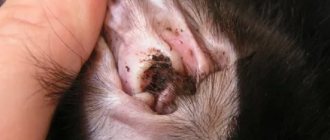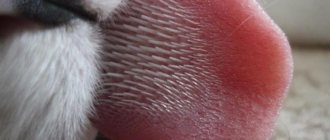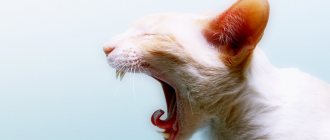Cleaning your cat's ears at home
Not only people, but also cats should have clean ears.
Does this mean that you need to clean your cat’s ears regularly? Not at all! Most cats cope well with this task on their own, with the only exceptions being some purely artificial breeds, such as Sphynxes and Scottish Folds. We will look at cleaning the pink ears of these girlfriends and their friends below. For now, let's talk about the erect ears of furry pets.
This is what good, healthy cat ears should look like:
Translucent, without bald spots on the outside, without spots or foreign inclusions on the inside, the guard hair covering the outside of the ear is clean and even.
Aesthetically revealing ears! Unhealthy ears look different. This ear should alert the owner:
If the sparse guard hair covering the ear performs its function - not to allow debris from the outside to enter, then the wax produced inside the ear does its own.
Otodectosis or ear mites
Otodectes (ear mites) is a common parasitic disease caused by the Otodectes cynotis mite. Mites infect the inner surface of the cat's ear, ear canal, and even the eardrum. In advanced forms of otodectosis, parasites invade the meninges, causing disturbances in the central nervous system.
Symptoms of the disease:
- the cat shakes its head, crusts and dirt fly out of its ears;
- an abundant dark brown or black wax deposit forms in the animal’s ears (this plaque is similar in structure to instant coffee);
- lethargy, increased body temperature in the cat, and bowed head may be observed;
- in advanced stages of the disease, the eardrum bursts, and the cat develops neuralgic disorders (fits, convulsions).
Otodectosis has pronounced symptoms, but the final diagnosis can be made by a veterinarian after testing for the presence of ear mites.
Treatment for ear mites in cats
Otodectosis therapy consists of three main measures:
- mechanical cleaning of the ears;
- use of acaricidal drugs;
- strengthening the cat's immunity.
The purpose of mechanical ear cleaning is to remove mites, their eggs and waste products, remove crusts and wax deposits from the ear canal. For this procedure, you need to use disinfectant solutions - furatsilin solution or 3% hydrogen peroxide. To more effectively clean the ear from parasites, it is recommended to use an acaricidal drug, acaromectin, in combination with disinfectants.
After cleaning the cat’s ears from mites and dirt, the ear canal is treated with acaricidal drugs - acaromectin, otoferanol or stronghode. To distribute the medication evenly, gently massage the cat's ears.
To strengthen the cat’s immunity, immunomodulators and vitamin therapy are used:
- ribotan;
- immunofan;
- gamavit;
- mineral and vitamin complexes.
When treating ear mites in a cat, it is necessary to carry out a complete disinfection of the house:
- wash and treat the animal’s bed, rugs and toys with disinfectants;
- Do wet cleaning with disinfectant solutions every day.
If you have several pets, then they also need to be shown to a veterinarian and prevent the disease. After the cat is treated for otodectosis, the veterinarian conducts a repeat test for the presence of parasites. Only if the test result is negative, the cat is considered healthy.
Prevention of otodectosis
Any disease is easier to prevent than to treat. Ear mites in cats are no exception. To prevent otodectosis it is necessary:
- regularly inspect the animal’s ears and clean them if necessary;
- treat the cat with antiparasitic agents in a timely manner;
- observe the rules of hygiene and cleaning of premises;
- Provide the cat with proper nutrition and proper care.
If you find one of the symptoms of otodectosis in your ward, immediately contact your veterinarian to diagnose the disease and prescribe treatment.
TREATING CAT'S EARS. EAR MITE. WE BURY A CAT'S EARS
When examining a kitten, you can sometimes notice suspicious dirty patches, inflammation and scratching on its ears, which may indicate the presence of ear mites. In advanced cases, purulent discharge may accumulate in the auricle, and the animal shakes its head restlessly. The disease is called otodectosis, and it is caused by tiny mites Ototdectes cynotus.
When examining a kitten, you can sometimes notice suspicious dirty patches, inflammation and scratching on its ears.
For humans, the tick is not dangerous, but dogs and other pets are susceptible to it. You can treat this disease yourself, but it is better to go to a veterinarian who will prescribe all the necessary procedures for your cat.
Erosion and ulcers of the ear in a cat
Erosion and ulcers in a cat’s ears are a manifestation of diseases of various etiologies. To diagnose and identify the causes of ulcers or erosion in the animal’s ears, it is necessary to conduct a comprehensive examination by a veterinarian. The doctor will conduct a cytological examination, hematological and biochemical tests.
If the cause of erosive-ulcerative dermatitis in a cat is associated with malfunctions in the immune system, then at the initial stage the veterinarian will prescribe the use of mechanical means of protection to prevent self-injury. For example, an Elizabethan collar, overalls or anti-scratch boots.
For the treatment of immune diseases the following is used:
Bacterial infections
Quite rarely, bacterial infections become the cause of ulcers and erosion in a cat’s ears. Treatment in this case consists of eliminating the cause and antimicrobial therapy. Effective methods of therapy can only be prescribed by a veterinarian after examination.
Neoplasms
It is extremely rare that papilloma, sarcoma or fibroma cause itching in a cat's ear. As these tumors grow, they lead to partial or complete hearing loss. To eliminate the tumor, the veterinarian performs surgery. In most cases, the prognosis is positive.
Otitis media in cats is a fairly common disease. Most cat owners consider it a harmless disease, but this is a dangerous misconception. If you do not contact a veterinarian in time, your cat may lose hearing or die from complications.
- ear mite;
- foreign body in the ear canal;
- hypothermia;
- water getting into the ear;
- old sulfur plug;
- injury;
- infectious diseases.
To treat otitis media, you need to contact a veterinarian. As a rule, topical drugs are used to treat the disease in combination with antibiotics and vitamin therapy.
How to clean wax from ears?
It is enough to carry out the ear cleaning procedure once a week if the animal is healthy. In case of illness, the frequency of cleansing will depend on the type of illness, as a rule, 2-3 times a week. The cat needs to clean its ears so as not to injure the animal. Special earwax drops for cats and cleansing gels will make the manipulation more comfortable. They can be purchased in specialized stores and pharmacies.
It is not recommended to use alcohol-containing and soap solutions yourself for instillation into the ears. This can provoke even greater release of sulfur.
To clean the auricle you will need cotton pads onto which cleansers are applied. A new disc is used for each ear. Cotton swabs are used with great care so as not to damage the eardrum. In a healthy cat, it will be enough to clean the ear shallowly by bending back the auricle. If difficulties arise, it is better to contact a veterinarian.
Regular grooming of your pet will help keep it healthy.
Why do cats love earwax?
Why do cats love sulfur and lick their owners' ears? The relationship between taste and olfactory receptors in cats and humans.
Biologists talk about why cats love sulfur this way: cats are not gourmets at all and have less than 500 taste buds (a person, for example, has about 10,000), which is compensated by a huge number of olfactory receptors - depending on the breed, a cat has them about 50 times more than in humans (and humans have about 5 million). Like people, these animals can only sense four basic tastes - bitter, sweet, salty, sour, and judge the suitability of a dish for food by smell. As a result, a cat cannot be forced to try food that smells bad or does not smell at all. What we call “earwax” is actually a mixture of fatty secretions (triglyceride fatty acids, waxes, cholesteryl esters) and dead skin cells. The cat smells ether and dead cells (which is protein) and understands that this substrate has nutritional properties. And, since the cat is a predator and it “targets” animal fats, it begins to intensively extract this useful substance from the human ear.
A person has a more subtle taste and will not eat sulfur due to the fact that it is bitter and sour, but a cat will simply practically not feel this combination and will enjoy the nutritious aroma.
Cat licks owner's ear
Articles on the same topic:
Why do cats eat grass? Can cats eat chocolate? Why do cats eat grass? Why do cats sleep on people? Why does a cat sneeze? What happens if you cut a cat’s whiskers?
- Colds in cats - symptoms, treatment
- When to castrate a cat
Why do cats love earwax?
Despite the fact that cats cannot be called gourmets due to the lack of a sufficient number of taste buds, they still have special food preferences. And, perhaps, the most interesting and unusual product from the entire cat diet can be called human earwax.
It would seem, what is missing from a well-fed cat, eating special food, that she licks her ear with such care and smacking? As it turned out, in this case the animal’s natural instincts awaken. The fact is that cats are not attracted to the taste of sulfur, but to its smell.
Earwax is a mixture of fatty secretions and dead cells that have a special unique aroma and are associated by the cat with the aromas of the natural environment. For example, dead cells are protein, and protein is a nutritional substance for any animal. If this smell is enhanced by ether, which is contained in the fatty residue, then the cat simply will not be able to resist the opportunity to get enough of the beneficial substances .
However, not all cats have a weakness for this range of tastes and smells, and this depends on the animal’s personal preferences. Therefore, you should not force a cat to lick its ears if it does not want to, otherwise, in addition to the ear plug, you can earn yourself deep scratches from an angry pet.
Is your cat such a foodie that she hunts your earwax like crazy? Some tailed animals go so far as to, while a person is sleeping, begin to crawl into his ears with their paws and lick them in order to get a little “drug”. What is the reason that a cat eats sulfur?
It turns out that it is not the taste that attracts him, but the smell. After all, cats do not have as many taste buds as humans do. But they have much more olfactory receptors, and it is they that encourage the animal to hunt for sulfur. The fact is that sulfur is dead cells consisting of protein and a special aromatic secretion. This blend of scents reminds cats of a nourishing source of protein that can fill them up. This is what the cat does.
In fact, sulfur actually contains a lot of useful substances, so you shouldn’t scold your cat for such addictions. It's another matter if she hurts you. Then, at the very moment when the cat begins to tear your ears, start hissing at her. This is a great move that helps without yelling or hitting. Cats instinctively know that the one who hisses is desperate and is ready to take the most drastic measures if the harassment does not stop.
It is worth noting that not all cats will be tempted by such a dish. It all also depends on personal preferences. If your cat is noticed to have such an addiction, then we will give one more piece of advice. Hide used ear sticks well, because some pets can be very creative in removing them even from a closed trash can.
Treatment at home
In order to provide proper and timely assistance to your pet, you should carefully examine its ears.
Ear mite
If the source of concern for the animal is a tick (Otodectes cynotis), upon examination you can see a filling that is uncharacteristic for a healthy organ. Sulfur looks atypical - a dry crust of brown or black color. The shell is inflamed, dark discharge is observed.
You should not remove the fillings yourself; this will complicate the examination and correct diagnosis. The doctor, through laboratory tests, will establish a complete clinical picture and prescribe treatment.
Ear mites in cats belong to the group of invasive ear diseases.
Having thoroughly cleaned the auricle of plaque and darkened wax, you should begin processing and direct treatment.
Treat with Tsipam, Amitrazine about 5 times every 3-5 days. Apply Aurican drops every day for seven days in a row. Repeat instillation for a month, twice a week. Moisten the fur of the affected area with Neostomazan solution and drip inside, repeat the procedure after a week.
For preventive purposes, Frontline, Stronghold, Bars are used - they are dripped onto the cat’s withers. During treatment, the cat is isolated from the outside world and contacts with other animals. Withstand the full rehabilitation period.
First aid for mild and moderate types of hematoma consists of applying a cold compress, a tight bandage, and changing it every other day. Usually within 14 days the hematoma resolves and you can proceed to UHF procedures.
A more complex case requires a serious approach from a qualified specialist – a veterinarian. At the clinic, they puncture the hematoma and suck out the blood contents. Instead, a solution of novocaine with an antibiotic, hydrocortisone, is administered. Secure with a tight bandage, which is changed after four days. Intramuscular injections of Vikasol are recommended.
Pustule (abscess)
If you find an abscess in your pet’s ear, under no circumstances should you squeeze it out. Most likely, as a result of damage - scratches, minor injuries - an abscess develops in the ear. By squeezing out a small abscess, you can provoke a more serious problem - sepsis, which is very difficult and often with an unfavorable outcome.
The abscess is opened, the purulent exudate is washed out and disinfected with furatsilin. In more complex cases, after cleaning the wound, strong antibiotics, restoratives, and painkillers are prescribed.
Yeast fungus
Yeast fungus in a cat
It is difficult to diagnose on your own, but it is possible. Inside there is an accumulation of atypically dark sulfur and an unpleasant odor. Thoroughly clean the sink with hydrogen peroxide once a day until the cotton swab turns white.
Intramuscular antibiotic Kabaktan once a day for a week. Immunomodulator Maxidin intramuscularly or subcutaneously, twice a day, five days in a row. Gamavit subcutaneously - 1 injection for five days. 3-4 drops of Otoferonol Gold. Every morning for about a week. For prevention - Otibiovin.
Treatment of otitis depends on the type of localization of inflammation. It is recommended to eliminate the symptoms before the doctor arrives.
Apply prednisolone ointment to the dried surface. Next, the doctor prescribes antibiotics and antihistamines. If necessary, novocaine blockade with an antibiotic, fungicidal agents.
Dermatitis or Eczema
Having found out that the cause of ear itching in a cat is dermatitis or eczema, the doctor prescribes the following treatment measures:
- douching with hydrogen peroxide, soapy water or soda solution;
- removal of dead particles of the epidermis;
- treatment of the affected area with astringents: a solution of silver nitrate, pyoctanin, picric acid, albucid;
- using a self-prepared ointment from zinc oxide, starch, lanolin, petroleum jelly;
- restorative therapy.
Allergies can be a trigger. Since there are no visible causes other than scratching by the pet itself, you should take it to the nearest clinic to have the allergen identified. Eliminated by cleaning with detergent solutions, antihistamines containing fatty acids. The use of corticosteroid ointments, injections, tablets, and immunostimulants is acceptable. Detailed step-by-step therapy is prescribed by the doctor after identifying the allergen.
How to properly clean cats ears at home
How often should I clean? It depends on the breed of the animal, its state of health, its age and temperament.
The activity of the sulfur glands depends on the breed.
Therefore, breeds that have small ears need ear checks and cleaning once every two weeks.
For example, fold-eared cats can have their ears cleaned once a month.
Cats that are accustomed to ear cleaning early are much more comfortable with this procedure.
Veterinarians advise accustoming your cat to ear cleaning from a young age, as this process is unpleasant.
A trained animal tolerates the procedure, while an untrained animal constantly twitches and tries to escape.
To minimize the risk of injury, it is best to use two people to clean the ears of an untrained animal, with one person cleaning and the other holding.
In addition, it is recommended to first trim your pet’s claws, or wear anti-scratch guards, and after the procedure, feed him a treat.
Before cleaning, the cat must be secured with a towel and the claws must be trimmed first.
To properly care for your cat, you need to prepare ear cleaning equipment in advance.
Typically, it consists of the following things:
- Cotton buds. You will need one or two of them on each side if they are clean, or three or four if the animal’s ears are dirty. Veterinarians prohibit the use of homemade cotton swabs for cleaning, such as sticks or matches with cotton wool, which can easily scratch the inside of the ear. It is best to use children's cotton swabs with a limiter.
- Ear cleaning gel. Many breeders use improvised means for cleaning, for example, vegetable oil and water. But it is much better to buy a special product - gel for cleaning cat ears. You can also use sterile saline solution. Under no circumstances should you use liquids containing alcohol for cleaning, or clean with hydrogen peroxide and regular soap, as this will lead to dry skin, ulcers, increased production of wax and itching.
- Towel. They need to restrain the cat, which may twitch or shake its head at the wrong moment. Often, sudden movements while cleaning the ears lead to injuries.
Ears are very sensitive organs that require careful handling.
Whether it is regular preventive or therapeutic cleaning, all actions should be performed very carefully and slowly, because a cat’s ears are very sensitive.
- To begin with, you need to turn your ear out as much as possible, bending it to the limit. This will facilitate access to the entire surface of the organ and thereby speed up the cleaning procedure.
- Dip a cotton swab into the gel and wipe the animal’s ear with it. Under no circumstances should you squeeze the gel directly inside.
- You should immerse a cotton swab into the ear to a depth of about a centimeter. Some owners are afraid to reach the eardrum and pierce it. But anatomically this is impossible due to its location.
- You should brush in an outward motion rather than an inward motion to clean out rather than push dirt out.
Folk remedies
If for some objective reason a visit to the doctor is temporarily impossible, then traditional medicine comes to the rescue. Herbs and lotions are unlikely to be able to completely cure otodectosis, but they may well be able to alleviate the animal’s suffering until the time of visiting the veterinary clinic.
- Green tea based drops. A tablespoon of dry leaves is poured into a glass of water and left for 5-10 minutes. After cooling to a warm state, the solution is taken into a pipette and a few drops are instilled into each ear.
- Garlic has powerful antiseptic properties. In the case of ear mites, it is infused in oil for 24 hours, and then the resulting solution is instilled into the ears once a day. Olive, flaxseed, sunflower, almond and other oils are used as the basis for the tincture.
- Celandine juice is instilled into the ears in the morning and evening, two drops per ear. Freshly picked herbs are ground in a meat grinder and then squeezed in gauze to prevent any remaining leaves or stems from getting into the juice ready for use.
And the last thing you should not forget about is to try to give the cat maximum attention and care in order not only to alleviate its suffering, but also to speed up the healing process.
Causes and diseases of cats that cause black plaque to appear
The dirt that owners find in their cat's ears is not always brown. Often its color is closer to black. The presence of a substance of this color in the ear means that the cat is most likely sick.
What exactly depends on the symptoms, but there are three main problems that almost every pet owner can face.
Otodectosis
This disease is caused by one of the most common parasites of cats - ear mites. Ear mites are arthropods that inhabit almost all ear canals and multiply rapidly.
It first settles in the outer ear. Having completely colonized it, the mite begins to colonize the medial and internal canals.
It is quite simple to determine that your cat has otodectosis - the brown plaque continues to accumulate even after its removal, which is why treatment must be started immediately.
The disease has several stages, which determine the method of treatment:
- Initial
- Launched
Each of them is characterized by its own symptoms:
- During the initial phase, the mass released from the shell is dry, like the surface of the ear itself. There is no scratching.
- At an advanced stage, the mass becomes more viscous, the ear becomes inflamed due to the appearance of colonies of fungi and bacteria.
Ear mites
When treating the first stage of the disease, it is enough to use Otodexin ear drops, aerosols and lotions. And the second requires the use of antibiotics and antimycotic agents.
At any stage of the disease, before starting the procedures, it is necessary to remove the plaque and crust that has formed on the surface of the ear.
Formation of sulfur plugs
If your cat belongs to a breed with an unusual ear structure, for example, a Sphynx, then it is highly likely that the cause of the dark plaque inside the ears is wax plug. These cats simply have increased sulfur production. It accumulates and various microorganisms develop in it.
The wax plugs themselves, although they cause discomfort for the cat, are quite harmless. But they can lead to inflammation. Therefore, avoid their occurrence simply by monthly preventative removal of excess wax from your pet’s ear.
The main way to treat wax plugs at home is by instilling a special lotion. As a result of this, it dissolves. If this still does not happen, contact your veterinarian.
Otitis
The accumulation of wax may be a sign of a more serious problem - otitis media. In fact, this is the name for severe inflammation of one of the ear canals.
Otitis is divided into:
- External
- Medial
- Interior
With internal otitis, only a veterinarian can help your pet. The first type of disease is the easiest to treat.
Otitis externa can be determined by the fact that the cat not only has black plaque in the ears, but the ears also smell bad. She can also itch a lot in the ear area.
Medial otitis media is often a consequence of untimely treatment at a previous stage of the disease.
If otitis externa is easy to cure with home remedies such as Bars drops, then with this type it is more difficult due to the structure of the animal’s ear. It is almost impossible to do without the help of a veterinarian.
Main symptoms:
- Constant discharge of fluid from the ears
- Squelching sounds
- The cat categorically does not allow you to touch the sore ear.
- Loses appetite
- The stench can be heard from a distance
The worst option is otitis interna because it can cause the cat to go deaf due to the disease spreading to the cerebrum. The only treatment is veterinary care.
Limitations and side effects
When using sulfur according to the instructions, complications and unwanted reactions occur extremely rarely. However, failure to comply with the dosage, as noted by veterinarians from the Zoovet clinic, can lead to death of the pet. If you apply ointment to the animal's skin without confirming the diagnosis, you can seriously aggravate the cat's condition. Incurable wounds and burns may occur. You should not forget about the rules of personal hygiene of the owners
If you have an allergic reaction to this component, you need to take precautions by adding sulfur to your pet’s food. It is better to use rubber gloves and a gauze bandage.
Diagnostics
When a stink appears from an animal's ear, it is recommended to begin the diagnosis with a visual examination. To see better, you can shine a flashlight into your ear.
What you should be wary of:
- strong smell of rot;
- smells like rotten meat;
- pus, black, brown discharge;
- blood, scabs;
- redness of the skin.
It is impossible to make an accurate diagnosis at home. For any alarming symptoms, contact a specialist.
Veterinarian actions:
- taking a blood test to identify the inflammatory process;
- examination using an otoscope;
- ear smear, bacteriological analysis of discharge;
- biopsy (used as a last resort).
If necessary and the disease is severe, the cat is left for treatment at a veterinary clinic. In milder cases, the doctor prescribes medications for home therapy.
How to identify ear mites:
- Discharge from the ears has a brown tint.
- The cat constantly shakes his ears and does not allow himself to be stroked.
- Body temperature rises, the animal becomes lethargic and restless.
- In the acute stage of the disease, touching the ears causes pain and tremors in the hind legs.
- Test: Use a cotton swab to take a small amount of discharge and shake it onto a black sheet of paper. If white moving dots appear, this is an ear mite.
Timely treatment prevents unpleasant consequences, hearing loss. The tick can cause inflammation of the brain, leading to death.
Structure and physiology of the ears
A cat's ears are a very important organ. With their help, the animal is perfectly oriented in space and hears what is happening in the surrounding world. The ear performs the function of the vestibular apparatus, maintaining the cat's balance. Therefore, it is very important to ensure that dirt does not accumulate in it and to clean it in a timely manner.
© shutterstock
In cats, a lot of wax can accumulate in the ears due to their complex structure. The ear consists of 3 sections :
- Outer ear . The auricle passes into the external auditory canal. The latter has a tortuous structure, and its surface secretes a softening secretion.
- Middle ear . Represented by the eardrum and the connection of several bones. On them, the membrane transmits sounds through vibrations.
- Inner ear . It contains a large number of tubes containing liquid - a labyrinth. The tubes are filled with liquid, which moves through them evenly. Thanks to this, the cat does not lose its balance.
Discharge from cats' ears should not cause concern to the owner, because it serves a protective function. If the released sulfur is odorless, light with a yellowish tint, this is normal and does not require treatment. A moderate amount of sulfur protects the inner surface of the ears from drying out, and prevents dangerous microorganisms, dust, and dirt from penetrating into the depths of the shell.
Owners often notice that their cat loves earwax. The animal likes the smell of the discharge. This is due to the varied chemical composition of sulfur. After all, it contains alcohol, mineral acids, cholesterol, and a special ester. The latter has a beneficial effect on the condition of the animal’s coat, making it smooth and shiny.
© shutterstock
Treatment of the disease
This disease can be successfully treated at home.
. Any pet store or veterinary pharmacy offers a wide range of products necessary for treatment. During the treatment process, you should carefully follow the recommendations of the veterinarian treating the animal, as otherwise the cat may develop deafness.
The incubation period of the tick is 21 days
, owners should not forget about this during treatment.
Many owners have opted for an ear cleaning product such as Rosinka lotion
, available in the form of a bottle with a pipette. The product must be injected into the cat's ear, then it should be folded and lightly massaged. The use of Rosinka should be limited to the required dosage, otherwise the owner will only flood the animal’s ear. If the cat has a restless disposition, it should be wrapped in a blanket or blanket during this procedure.
After the massage, the contents of the auricle are removed using a cotton swab. Remains of black plaque are removed with cotton swabs; this procedure should be carried out with extreme care in order to prevent damage to the ear canal.
The next step in treating a cat will be the use of ear drops ( Amitrazine, Amit, Akromectin
). The duration of use of the drug must always be agreed with the treating veterinarian.
Also, cats should smear their withers with anti-tick drops (Leopard), which at the same time rid the pet of fleas.
If the owner of a cat of any breed knows the main symptoms of the most common ailments among them, then he will never allow the disease to develop and its advanced stage, since he will be able to show the animal to a veterinarian in time and begin the correct necessary treatment.
If you look closely at the brown coating on the animal’s ears, you will notice that its structure is similar to the grounds left after drinking coffee. In addition, if there are mites, this very plaque has a very unpleasant and even quite pungent odor.
If the owner of a feline has such an opportunity, then it is best to take your pet to a veterinarian as soon as possible. But in general, you can cope with the problem yourself. To do this, you just need to purchase a special drug to combat ear mites. For example, a special medicinal liquid “Bars” would be an excellent option. It is sold in pet stores and specialized veterinary pharmacies. In addition to the high effectiveness of such a drug, its attractive cost can also be noted as an advantage.
It is best to first securely secure the animal with a thick blanket to avoid painful scratches. The cat's ear is carefully turned out so that its internal cavity becomes visible, after which the brown plaque that has appeared is carefully removed from its surface with a cotton swab dipped in the purchased medicinal solution.
The main thing is to do it slowly and carefully so as not to hurt the animal. It is best to try to change quickly dirty cotton swabs more often.
Veterinarians note that the result of such cleaning can be consolidated with the help of boric acid. A small amount is poured into the cat's ear immediately after the procedure. The main thing is to pour the substance not into the ear canal, but precisely into those places where the unpleasant-smelling brown plaque was previously located.
It is very important to “wield” the cotton swab only at a minimum depth. Otherwise, the pet owner can seriously damage his pet’s ear.
For example, due to a damaged eardrum, a cat may completely lose hearing.
What should you do if your cat's ears are itchy and black? Inexperienced cat owners often make the mistake of mistaking black or brown plaque in their pet's ears for earwax or dirt. Some simply make no attempt to get rid of it, others simply clean the “dirt” with a cotton swab. In fact, if a cat has black ears, then this is a clear sign of a disease called “otodecosis.” It is caused by microscopic mites. In this case, it is necessary to urgently take treatment measures.
The second name for this common disease in cats and dogs is ear scabies. An animal suffering from this disease experiences very severe discomfort and also scratches its ears until they bleed.
How to do it
As a rule, cats do not like the procedure for removing wax deposits. As a result, the animal will resist it with all its might if it has not been trained to such actions since childhood. Therefore, you should know how to properly clean cats’ ears to protect yourself from injury and them from stress. There are certain simple rules that will help you carry out the procedure as safely as possible:
- If the cat was not taught to clean its dirty ears when it was a kitten, then it is better to carry out the procedure together. One person will hold the animal, and the other will perform cosmetic procedures.
- The animal should definitely trim its claws just in case.
- If you don't have a partner, you can wrap the cat in a towel, leaving only his head exposed, allowing you to work with it.
- Now you need to carefully bend the auricle and wipe the ears with a cotton swab with hydrogen peroxide or a special ear cleaning liquid, which can be purchased at a pet store.
- Veterinarians use cotton swabs to clean a cat’s ears, but the animal’s ears are quite complex and very delicate, so at home it’s better not to take risks and use a cotton swab, which will cope with the cleaning task just as well.
- After the cosmetic procedure, you need to caress the animal and be sure to give it its favorite treat.
- How to clean a kitten's ears, should babies' ears be cleaned, and should the owner even do it? A kitten's ears are so delicate that it is better not to clean them, but to wash them. This is done using special products sold in veterinary pharmacies. It is better to check with your veterinarian first which drops are best for your baby. This is the most gentle cleaning method that can also be used for adult cats. Its essence is simple: a few drops of cleaning agent are placed in the cat's ear according to the instructions, then the ears are easily massaged, the kitten is released, shakes its head and throws out wax deposits from the ear canals, which are quickly removed with a swab or sticks.
Why does a cat scratch his ears and shake his head?
Cats take care of their own hygiene. However, four-legged pets are not able to take care of the cleanliness of their ears.
If you occasionally notice that your pet is scratching its ears, then you should not panic. In this way, the pet tries to get rid of the accumulated wax in the ears. However, if your cat scratches its ears and shakes its head more intensely than usual, or becomes irritable and nervous, you should be wary. Most likely, there is a problem with the pet's hearing organs.
The main reasons why a cat scratches its ears:
- Getting water or a foreign object into the ear;
- Bruise and hematoma of the auricle;
- Absence or improper ear hygiene;
- Anatomical features of the auricle;
- External parasites (fleas, ticks);
- Skin diseases;
- Ear infection.
In this article, we will help you figure out why your cat is scratching his ears and what to do in such a situation.
Causes and consequences of earwax accumulation
If wax appears in your cat's ears, you need to find out why it occurred. There may be several reasons :
- natural ear contamination;
- intensive work of the sulfur glands (depending on the breed);
- excessive cleaning of the ear;
- diseases of the pet (mites, otitis media);
- foreign object in the ear.
When examining the ears, special attention should be paid to the color of the wax. If it is black or dirty green in color, and even has an unpleasant odor, this is a symptom of a dangerous disease.
The black color of wax may be due to dried blood from an ear injury. Another reason is an infested tick. Its waste products give it a black color. Brown purulent discharge with an unpleasant odor is a consequence of infectious diseases. The fungal nature of the disease also produces dark discharge. For a correct diagnosis, it is recommended to contact a veterinary clinic.
Regular care of your pet's ears will relieve him of unpleasant consequences . Excessive accumulation of sulfur can lead to complete or partial loss of hearing, disorientation of the animal in space, nausea, and vomiting. An inflammatory process may begin that will affect the animal’s brain, since the ears are directly connected to it.
© shutterstock











